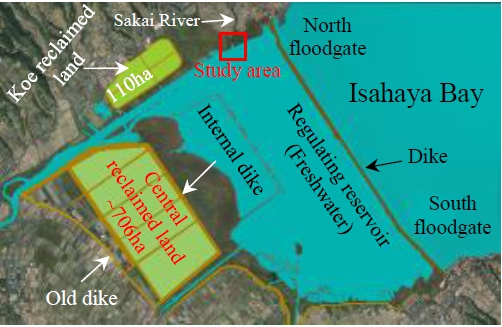Hydrodynamic Simulation of Suspended Solids Concentration in Isahaya Regulating Reservoir DOI: 10.32526/ennrj.18.2.2020.20
Main Article Content
Abstract
In this study, Osaka daigaku estuary model (ODEM) was applied for hydrodynamic simulation of suspended solids (SS) concentration in the Isahaya regulating reservoir. Water samples were collected every hour from 9:00 to 15:00 at nine sampling points inside the observation area of the reservoir. Parameters used for the model included initial conditions (i.e., SS concentration, water depth, temperature, and salinity) and boundary conditions (i.e., wind speed and direction, atmospheric temperature, solar irradiation, and cloud cover). The calculated results of SS in the reservoir and its concentration fluctuation from the model were compared with those estimated from the image analysis of unmanned aerial vehicle (UAV) and observed results. The SS simulated from ODEM distributed in high concentration, whereas that estimated from UAV distributed in low concentration although in both data they spread across a wide range at most investigated times. Although there was a big difference between the accuracy of ODEM and UAV, the SS concentration values described by them were closed to the observed values. Between them, the ODEM model showed its advantages in simulating the SS concentration and achieved more accuracy than UAV, showing a potential for using ODEM model in monitoring of SS in water.
Article Details
Published articles are under the copyright of the Environment and Natural Resources Journal effective when the article is accepted for publication thus granting Environment and Natural Resources Journal all rights for the work so that both parties may be protected from the consequences of unauthorized use. Partially or totally publication of an article elsewhere is possible only after the consent from the editors.
References
2. Chebbo G, Bachoc A. Characterization of suspended solids in urban wet weather discharges. Water Science and Technology 1992;25(8):171-9.
3. Dwinovantyo A, Manik HM, Prartono T, Ilahude D. Estimation of suspended sediment concentration from Acoustic Doppler Current Profiler (Adcp) instrument: A case study of Lembeh Strait, North Sulawesi. IOP Conference Series: Earth and Environmental Science 2017;54(1):012082
4. Ganti A. Correlation coefficient [Internet]. 2019 [cited 2020 Jan 20] Available from: https://www.investopedia.com/terms/c/ correlationcoefficient.asp.
5. Gartner JW. Estimating suspended solids concentrations from backscatter intensity measured by acoustic doppler current profiler in San Francisco Bay, California. Marine Geology 2004;211(3-4):169-87.
6. Harris DC. Quantitative Chemical Analysis. USA: Craig Bleyer; 2007.
7. Hodoki Y, Murakami T. Effects of tidal flat reclamation on sediment quality and hypoxia in Isahaya Bay. Aquatic Conservation: Marine and Freshwater Ecosystems 2006;16(6):555-67.
8. Kim S, Hayami Y, Tai A, Tada A. The Mechanism of bottom water variation in summer at the northern mouth of Isahaya Bay, Japan. Journal of Oceanography 2018;74(6):595-605.
9. Koga K, Vongthanasunthorn N, Araki H, Yamanishi H, Kawabe M, Ohwa N. Study on water quality analysis in the reservoir of Isahaya Bay land reclamation project. Environmental Engineering Research 2003;40:541-50.
10. Krawczyk D, Gonglewski N. Determining suspended solids using a spectrophotometer. Sewage and Industrial Wastes 1959;31(10):1159-64.
11. Li M-C, Liang S-X, Sun Z-C, Zhang G-Y. Optimal dynamic temporal-spatial parameter inversion methods for the marine integrated element water quality model using a data-driven neural network. Journal of Marine Science and Technology 2012;20(5):575-83.
12. Liang S, Nakatsuji K, Sun Z, Yamanaka R, Dalian P. Residual circulation system and its driving mechanism in the Bohai Sea. International Conference on Estuaries and Coasts; 2003 Nov 9-11; Hangzhou: China; 2003.
13. Liang S, Yamanaka R, Nakatsuji K. Typical seasonal circulation in the Bohai Sea. Proceedings of the Thirteenth (2003) International Offshore and Polar Engineering Conference; 2003 May 25-30; Honolulu, Hawaii: USA; 2003.
14. Magee MR, Wu CH. Response of water temperatures and stratification to changing climate in three lakes with different morphometry. Hydrology and Earth System Sciences 2017;21(12):6253-74.
15. Mitsugi Y, Vongthanasunthorn N, Mishima Y, Koga K, Araki H, Ittisukananth P. Long-term change of water quality in the reservoir of the Isahaya Bay reclamation project. Lowland Technology International 2013;15(1):21-8.
16. Murakami S, Tsujimoto T, Nakagawa H. Pick-up rate of sand and gravels. Japan Society of Civil Engineers 1992;(443):9-16.
17. Nagase S, Mishima Y, Mitsugi Y, Araki H, Yamanishi H, Koga K. Study on behavior of suspended solids under seawater in the reservoir of the Isahaya Bay reclamation project. Japan Society of Civil Engineers 2014;70(6): II_167-II_73.
18. Niki M, Nishida W, Noguchi M, Hashimoto A. Study on prediction and evaluation of water quality change in Isahaya regulating reservoir. Proceedings of Hydraulic Engineering 1999;43:1007-12.
19. Nishida W, Noguchi M, Yanamoto S. Prediction of the water quality change under a construction of sea dyke. Proceedings of Hydraulic Engineering 1997;41:457-62.
20. Nishida W, Suzuki S, Uehara Y, Shige R, Nozoe Y. Spatial and temporal changes of suspended solids in the northern waters of Isahaya Bay reclamation reservoir. Japan Society of Civil Engineers 2014;70(7):III_341-III_47.
21. Sasaki K. Changes in water quality of the regulating reservoir and impacts of Isahaya Bay reclamation project on Isahaya Bay and the Ariake Sea. Environment and Fisheries in the Ariake Sea 2017;4:13-5.
22. Schaeffer BA, Schaeffer KG, Keith D, Lunetta RS, Conmy R, Gould RW. Barriers to adopting satellite remote sensing for water quality management. International Journal of Remote Sensing 2013;34(21):7534-44.
23. Shahzad MI, Meraj M, Nazeer M, Zia I, Inam A, Mehmood K, Zafar H. Empirical estimation of suspended solids concentration in the indus delta region using Landsat-7 Etm+ imagery. Journal of Environmental Management 2018;209:254-61.
24. Tada A, Nakamura T, Sakai SI, Mizunuma M, Takenouchi K. Study on the characteristics of surface layer’s currents around the mouth of Isahaya Bay. Coastal Environmental and Ecosystem Issues of the East China Sea 2010:13-27.
25. Thanh VQ, Reyns J, Wackerman C, Eidam EF, Roelvink D. Modelling suspended sediment dynamics on the subaqueous delta of the Mekong River. Continental Shelf Research 2017;147:213-30.
26. Valkama P, Ruth O. Impact of calculation method, sampling frequency and hysteresis on suspended solids and total phosphorus load estimations in cold climate. Hydrology Research 2017;48(6):1594-610.
27. Yamaguchi S, Hayami Y. Impact of Isahaya dike construction on concentration in the Ariake Sea. Journal of Oceanography 2018;74(6):565-86.

